Dreadlocked university student Suhaib Attar clutches a can of spray paint as he sets to work on the latest gloomy corner of Jordan’s capital that he has turned into his canvas. The leading light of a tiny group of graffiti artists, the 25-year-old is on a mission — daubing flowers, faces and patterns across Amman to bring more color to the lives of its four million inhabitants.
“Our city is beautiful but it needs to be brightened up,” Attar says.
The aim is to “transform these great big walls of dull concrete into an expressive painting that is full of life,” he says.
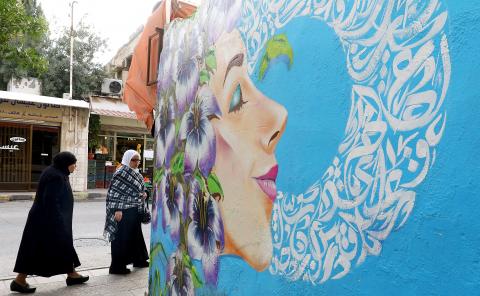
Photo: AFP
Built on seven hills that give their names to the main districts, Amman has been home to a small graffiti community for some years.
And while they may number fewer than 10, the artists have been busy.
Their eye-catching designs have begun popping up around the city center — especially the oldest Jabal Amman and Jabal al Lweibdeh neighborhoods where lots of foreigners live.
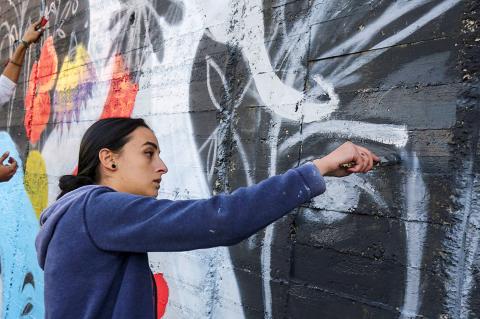
Photo: AFP
STRUGGLE FOR PERMISSION
In a conservative society like Jordan’s the graffiti artists have constantly had to challenge convention to carve out a niche for their works. But the art still faces limits like other forms of expression — and Attar says he steers away from politics and religion.
“I avoid topics that may shock some people who do not understand this art yet,” the street artist explains.
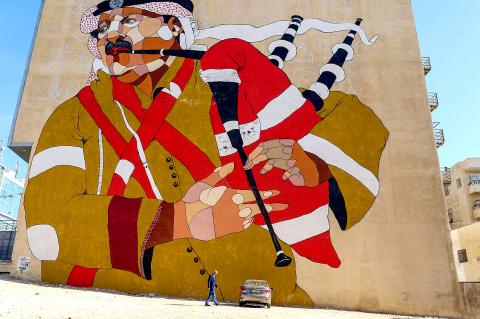
Photo: AFP
Art student Suha Sultan has experienced first hand the suspicion — and hostility — that sometimes meets her work.
“I was doing a large portrait of a tribal man and passersby started questioning me, lecturing to me because I was up a ladder among a group of men,” she recounts. “They interrogated me about the meaning of my graffiti.”
Sultan says that as she walks around Amman she itches to use her skills to revitalize the many soulless expanses of wall she sees. “But it isn’t so simple as to do the graffiti we need to get prior permission from the municipal authorities or the owner of the building,” she explains.
“Most of the time we end up getting refused and sometimes we face rejection by members of society.”
RED LINES
Painter Wissam Shadid, 42, agrees that there are “red lines” that cannot be crossed in a society steeped in tradition where artistic creation can be curbed. “We paint nature, animals, portraits, but we don’t touch at all subject connected to morality,” the street artist says.
But even that makes for an impressive change around the Jordanian capital.
“Before there were only the names of football clubs, phone numbers or messages from young guys to their friends scrawled on walls,” Shadid says. “Now we are trying to make our art more popular.”
And as graffiti makes inroads in Jordan it is increasingly drawing admiration from some locals and visitors. “It adds color to the city as buildings here can all look alike,” says Phoebe Carter, an American studying Arabic in the kingdom.
Jordanian Karim Saqr, 22, agrees that the works bring a much-needed splash of excitement. “When I spend the morning near a wall with beautiful graffiti, it fills me with positive energy for the rest of the day.”
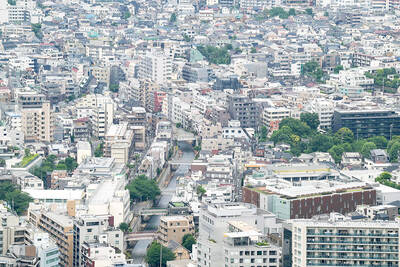
The canonical shot of an East Asian city is a night skyline studded with towering apartment and office buildings, bright with neon and plastic signage, a landscape of energy and modernity. Another classic image is the same city seen from above, in which identical apartment towers march across the city, spilling out over nearby geography, like stylized soldiers colonizing new territory in a board game. Densely populated dynamic conurbations of money, technological innovation and convenience, it is hard to see the cities of East Asia as what they truly are: necropolises. Why is this? The East Asian development model, with
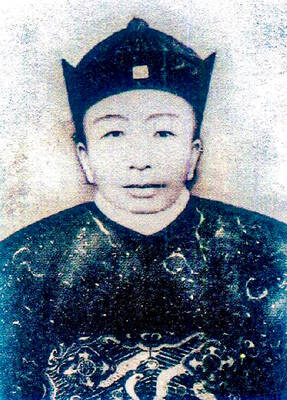
June 16 to June 22 The following flyer appeared on the streets of Hsinchu on June 12, 1895: “Taipei has already fallen to the Japanese barbarians, who have brought great misery to our land and people. We heard that the Japanese occupiers will tax our gardens, our houses, our bodies, and even our chickens, dogs, cows and pigs. They wear their hair wild, carve their teeth, tattoo their foreheads, wear strange clothes and speak a strange language. How can we be ruled by such people?” Posted by civilian militia leader Wu Tang-hsing (吳湯興), it was a call to arms to retake

This is a deeply unsettling period in Taiwan. Uncertainties are everywhere while everyone waits for a small army of other shoes to drop on nearly every front. During challenging times, interesting political changes can happen, yet all three major political parties are beset with scandals, strife and self-inflicted wounds. As the ruling party, the Democratic Progressive Party (DPP) is held accountable for not only the challenges to the party, but also the nation. Taiwan is geopolitically and economically under threat. Domestically, the administration is under siege by the opposition-controlled legislature and growing discontent with what opponents characterize as arrogant, autocratic
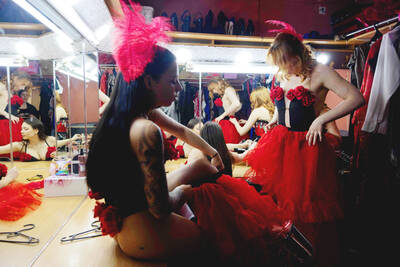
When Lisa, 20, laces into her ultra-high heels for her shift at a strip club in Ukraine’s Kharkiv, she knows that aside from dancing, she will have to comfort traumatized soldiers. Since Russia’s 2022 invasion, exhausted troops are the main clientele of the Flash Dancers club in the center of the northeastern city, just 20 kilometers from Russian forces. For some customers, it provides an “escape” from the war, said Valerya Zavatska — a 25-year-old law graduate who runs the club with her mother, an ex-dancer. But many are not there just for the show. They “want to talk about what hurts,” she